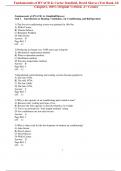Exam (elaborations)
Test Bank For Fundamentals of HVACR 4th Edition By Carter Stanfield, David Skaves (All Chapters, 100% Original Verified, A+ Grade)
- Module
- Institution
Test Bank For Fundamentals of HVACR 4th Edition By Carter Stanfield, David Skaves (All Chapters, 100% Original Verified, A+ Grade) Test Bank For Fundamentals of HVACR 4e By Carter Stanfield, David Skaves (All Chapters, 100% Original Verified, A+ Grade)
[Show more]



